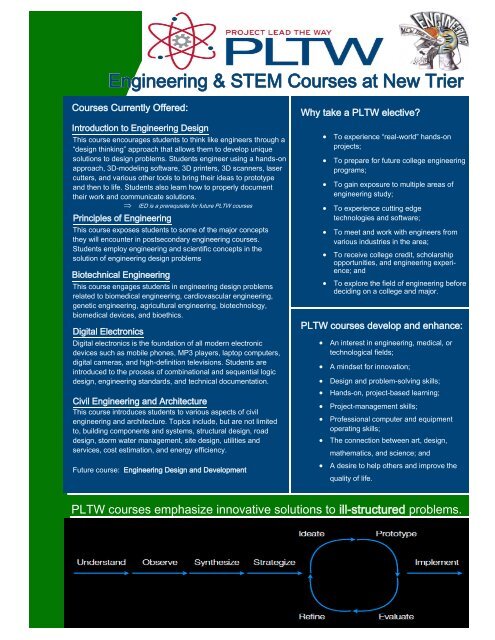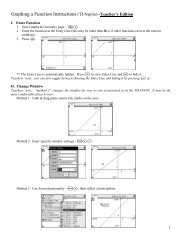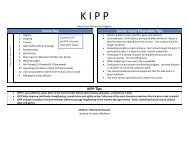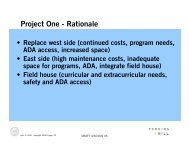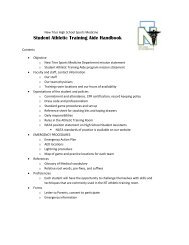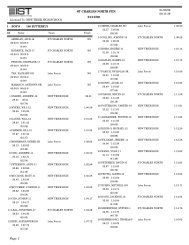Introduction to Engineering Design - PLTW
Introduction to Engineering Design - PLTW
Introduction to Engineering Design - PLTW
Create successful ePaper yourself
Turn your PDF publications into a flip-book with our unique Google optimized e-Paper software.
<strong>Engineering</strong> & STEM Courses at New Trier<br />
Courses Currently Offered:<br />
<strong>Introduction</strong> <strong>to</strong> <strong>Engineering</strong> <strong>Design</strong><br />
This course encourages students <strong>to</strong> think like engineers through a<br />
“design thinking” approach that allows them <strong>to</strong> develop unique<br />
solutions <strong>to</strong> design problems. Students engineer using a hands-on<br />
approach, 3D-modeling software, 3D printers, 3D scanners, laser<br />
cutters, and various other <strong>to</strong>ols <strong>to</strong> bring their ideas <strong>to</strong> pro<strong>to</strong>type<br />
and then <strong>to</strong> life. Students also learn how <strong>to</strong> properly document<br />
their work and communicate solutions.<br />
IED is a prerequisite for future <strong>PLTW</strong> courses<br />
Principles of <strong>Engineering</strong><br />
This course exposes students <strong>to</strong> some of the major concepts<br />
they will encounter in postsecondary engineering courses.<br />
Students employ engineering and scientific concepts in the<br />
solution of engineering design problems<br />
Biotechnical <strong>Engineering</strong><br />
This course engages students in engineering design problems<br />
related <strong>to</strong> biomedical engineering, cardiovascular engineering,<br />
genetic engineering, agricultural engineering, biotechnology,<br />
biomedical devices, and bioethics.<br />
Digital Electronics<br />
Digital electronics is the foundation of all modern electronic<br />
devices such as mobile phones, MP3 players, lap<strong>to</strong>p computers,<br />
digital cameras, and high-definition televisions. Students are<br />
introduced <strong>to</strong> the process of combinational and sequential logic<br />
design, engineering standards, and technical documentation.<br />
Civil <strong>Engineering</strong> and Architecture<br />
This course introduces students <strong>to</strong> various aspects of civil<br />
engineering and architecture. Topics include, but are not limited<br />
<strong>to</strong>, building components and systems, structural design, road<br />
design, s<strong>to</strong>rm water management, site design, utilities and<br />
services, cost estimation, and energy efficiency.<br />
Future course: <strong>Engineering</strong> <strong>Design</strong> and Development<br />
Why take a <strong>PLTW</strong> elective?<br />
To experience “real-world” hands-on<br />
projects;<br />
To prepare for future college engineering<br />
programs;<br />
To gain exposure <strong>to</strong> multiple areas of<br />
engineering study;<br />
To experience cutting edge<br />
technologies and software;<br />
To meet and work with engineers from<br />
various industries in the area;<br />
To receive college credit, scholarship<br />
opportunities, and engineering experience;<br />
and<br />
To explore the field of engineering before<br />
deciding on a college and major.<br />
<strong>PLTW</strong> courses develop and enhance:<br />
An interest in engineering, medical, or<br />
technological fields;<br />
A mindset for innovation;<br />
<strong>Design</strong> and problem-solving skills;<br />
Hands-on, project-based learning;<br />
Project-management skills;<br />
Professional computer and equipment<br />
operating skills;<br />
The connection between art, design,<br />
mathematics, and science; and<br />
A desire <strong>to</strong> help others and improve the<br />
quality of life.<br />
<strong>PLTW</strong> courses emphasize innovative solutions <strong>to</strong> ill-structured problems.
Facts and College Options:<br />
<strong>PLTW</strong> Facts:<br />
<strong>PLTW</strong> works. When surveyed, 80% of the<br />
high school seniors in the program<br />
indicated their primary area of study after<br />
high school would be in engineering,<br />
technology or computer science.<br />
<strong>PLTW</strong> helps influence and engage women<br />
in engineering. Female student<br />
participation in <strong>PLTW</strong> courses exceeds or is<br />
comparable <strong>to</strong> participation in college<br />
engineering programs.<br />
New Trier Project Lead the Way Course Sequence:<br />
<strong>Introduction</strong> <strong>to</strong> <strong>Engineering</strong> <strong>Design</strong> (IED)*<br />
In college, a high percentage engineering<br />
majors drop out or change their major<br />
because they did not experience<br />
engineering in high school. <strong>PLTW</strong><br />
students have an 85% student retention<br />
rate in the 2nd year compared <strong>to</strong> 40%<br />
nationwide.<br />
Observations by independent entities have<br />
shown that <strong>PLTW</strong> increases student<br />
aptitude in STEM (Science, Technology,<br />
<strong>Engineering</strong>, and Math) fields and<br />
increases retention rates in college<br />
engineering programs.<br />
Principles of <strong>Engineering</strong><br />
Digital<br />
Electronics<br />
College Options:<br />
Civil <strong>Engineering</strong> and Architecture<br />
Future Course:<br />
<strong>Engineering</strong> <strong>Design</strong><br />
Biotechnical and Development<br />
<strong>Engineering</strong><br />
(Research)<br />
The University of Wisconsin-Madison<br />
suggests that students who take <strong>PLTW</strong><br />
courses achieve higher test scores in non-<br />
STEM subject areas.<br />
<strong>PLTW</strong> alumni study engineering and<br />
technology at 5 <strong>to</strong> 10 times the rate of non-<br />
<strong>PLTW</strong> students.<br />
<strong>PLTW</strong> students exceeded the average<br />
academic growth rate over one year of the<br />
virtual control group in science concepts<br />
and processes and in mathematics. <strong>PLTW</strong><br />
students also exceeded the average<br />
academic growth rate over one year of non-<br />
<strong>PLTW</strong> students in science concepts,<br />
processes and in mathematics. (2010<br />
study)<br />
Any Project Lead the Way course taken at New Trier has a designated<br />
<strong>PLTW</strong> title listed on the transcript. Students who earn a “B’ average or<br />
higher in their <strong>PLTW</strong> course and pass a college credit exam (similar <strong>to</strong> an<br />
AP Exam) are eligible <strong>to</strong> register for college credit at participating schools.<br />
Some schools do not give direct college credit. However, they look for high<br />
school pre-engineering courses (<strong>PLTW</strong>) on a student’s transcript. They<br />
also encourage students <strong>to</strong> discuss their experiences in those courses in<br />
their essays.<br />
Please see your instruc<strong>to</strong>r for more information.<br />
Currently, there are over 1,300,000<br />
engineering jobs available in the U.S.<br />
without trained people <strong>to</strong> fill them.<br />
We need more engineers!


